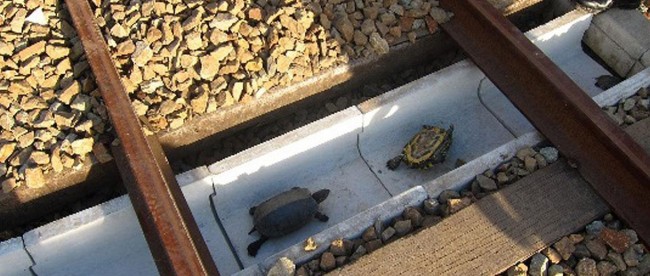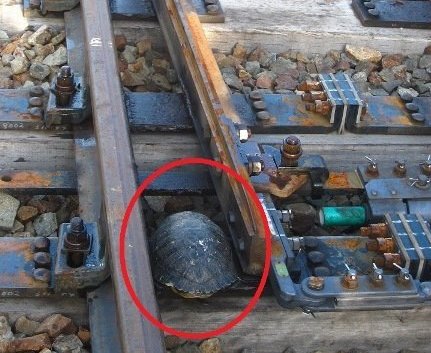The Tunnels that Save Turtles from Trains

The Japanese city of Kobe is the sixth-largest in the nation (by population). Like most other Japanese cities, it is a coastal city and one that is very reliant on trains for transit. In general, those two traits do not conflict with one another, but there are exceptions. For example, there are turtles and train tracks, and the two don’t mix all that well.
The problem, which sounds like a chicken-crossing-the-road joke, is pretty simple to explain: turtles try to cross the tracks to get to, well, wherever turtles go. In most cases, the turtles climb over the first rail, walk slowly over it toward the second rail, and, ultimately climb over that rail as well. Unless the turtle is on the rail as the train comes zooming by, it’s a pretty safe trip for the turtle — and it’s almost always a non-issue for the train. So in most cases, the turtles aren’t a problem.
There’s an exception, though. If a turtle crosses at a railway junction, there’s a good chance it will get trapped there. The turtles move rather slowly and if the switch points move, the turtle can’t react quickly enough to avoid the moving rail. Instead, the points push toward the rail, crushing the turtle in the process. Here’s a picture of such an incident, via Suma Aqualife Park (Kobe’s aquarium), with the turtle circled in red:

And this isn’t just a problem for the turtle. It’s also a problem for all those commuters who rely on the train system. The turtle blocks the switch points from connecting up with the rails, delaying service until someone can remove the reptilian obstruction. According to Asahi Digital (a Japanese-language source), a turtle blocking the points caused, on average, about one delay per year since 2002. That’s a big deal — as noted in the bonus fact below, train delays are rare in Japan. So West Japan Railway Company, the corporation which runs the train lines, looked for a solution. They teamed up with the local aquarium to develop the device seen below.

These “U-shaped concrete ditches,” as described by Japan Today, are positioned near junctions, in hopes that the most at-risk turtles will topple their way into them. The turtles can’t typically climb out of the ditches, unfortunately, but raliway staff comes by at least once a month to pull out any animals trapped within. From April 2005 through when the Japan Today article hit the presses in November, ten such animals were rescued.
A short video of the ditches in action can be seen here.
Bonus Fact: Japanese trains tend to run very close to schedule, and it’s rare for one to miss its scheduled arrival or departure time. As a result, you can’t blame your tardiness on a delayed train — it’s simply too unbelievable. So in the rare case when a train is, in fact, the cause of one’s lateness, railway systems issue “delay certificates” to affected riders. As Wikipedia explains, “the certificate is issued when delays as little as five minutes occur, and even for instances where the delay is caused by circumstances beyond the railway company’s control.” Employers, educators, and the like are expected to treat the tardiness as excused, and act appropriately.
Also: How do they keep the trains so punctual? Here’s a video which explains a lot of it, but there is nothing about turtle tunnels.
From the Archives: Ninjas Need Not Apply: When are Teenage Mutant Ninja Turtles not Teenage Mutant Ninja Turtles?
Take the Quiz: Train or roller coaster?
